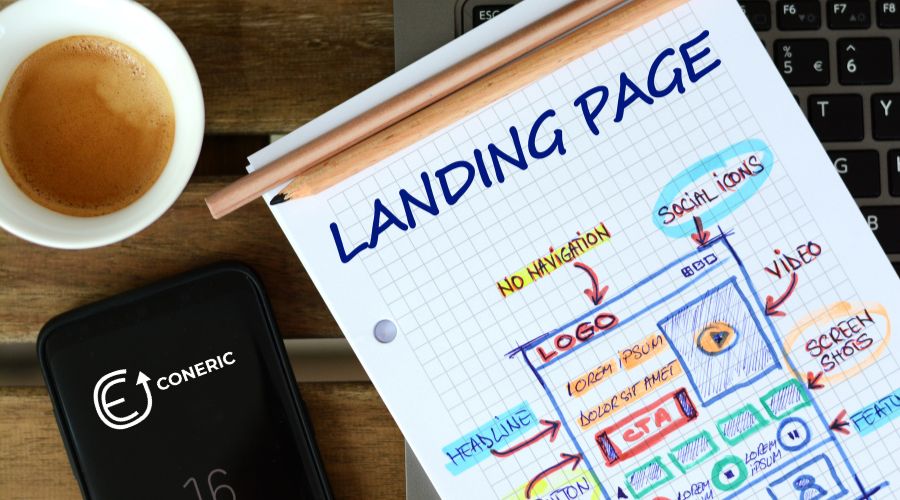En CONERIC, sabemos que el diseño de una landing page efectiva puede marcar la diferencia entre un clic perdido y un nuevo cliente.
Una página de aterrizaje bien construida no solo atrae visitas: las convierte en resultados reales.
En esta guía descubrirás las mejores prácticas de diseño, ejemplos inspiradores y principios de marketing neuronal que harán que tus páginas conviertan como nunca antes.
💡 Comprendiendo la esencia de una landing page
Una landing page (página de aterrizaje) es una página web independiente creada con un propósito: convertir visitantes en clientes o leads.
A diferencia de la página principal o un artículo de blog, su misión es una sola: inspirar acción inmediata.
🔑 Elementos esenciales del diseño de una landing page efectiva
🧠 Título principal (Headline)
Tu titular debe ser claro, directo y emocional. Es la primera impresión, y debe comunicar el valor de tu oferta en segundos.
El cerebro humano decide en menos de 3 segundos si algo le interesa; un buen titular puede cambiarlo todo.
🚀 Llamado a la acción (CTA)
El CTA es el botón o enlace que motiva a actuar.
Debe destacar visualmente y usar verbos de acción: Descargar ahora, Reserva tu lugar, Obtén tu guía gratuita.
Un CTA poderoso activa la zona cerebral asociada con la recompensa inmediata.
📝 Formulario simple
Cuanto más fácil, mejor.
Solicita solo la información esencial: nombre, correo o teléfono. Cada campo adicional puede reducir la conversión.
🖼️ Visuales de alto impacto
Usa imágenes o videos que conecten emocionalmente con tu oferta.
El cerebro procesa las imágenes 60 000 veces más rápido que el texto, y un visual relevante puede duplicar tu tasa de clics.
🧩 Mejores prácticas para diseñar landing pages que convierten
1. Simplicidad ante todo
Una landing page efectiva guía la mirada y la mente hacia una sola acción.
Evita distracciones, enlaces innecesarios o textos extensos. Menos ruido = más resultados.
2. Colores contrastantes y estratégicos
El color puede aumentar la conversión hasta un 30 %.
Usa tonos contrastantes en botones y formularios para dirigir la atención del visitante donde deseas que actúe.
3. Prueba social que genere confianza
Incorpora testimonios, valoraciones o logotipos de clientes.
La prueba social activa el principio de validación inconsciente: “Si otros lo eligieron, debe ser bueno.”
4. Diseño adaptable a móviles
Más del 70 % de las visitas provienen de dispositivos móviles.
En CONERIC diseñamos landing pages totalmente responsive, optimizadas para ofrecer una experiencia perfecta sin importar el dispositivo.
5. Prueba, mide y optimiza
Una landing page perfecta no se improvisa, se perfecciona con datos.
Aplicamos pruebas A/B, analizamos clics, mapas de calor y conversiones reales para descubrir qué diseño genera más resultados.
🧠 Ejemplos inspiradores de landing pages efectivas
🌍 Airbnb
Simplicidad total. Su titular transmite valor (“Viaja como un local”) y su botón de acción es claro y directo.
💬 Slack
Combina colores contrastantes, testimonios y mensajes de comunidad.
Su CTA (“Probar gratis”) elimina fricción y motiva a actuar.
☁️ Dropbox
Minimalismo visual con mensajes claros. Su página guía al usuario sin distracciones hacia el registro.
🚀 Diseñar para convertir: el arte detrás del impacto
Diseñar una landing page no es solo cuestión de estética.
Es una mezcla de psicología, diseño y estrategia digital.
En CONERIC, aplicamos principios de marketing neuronal para guiar al visitante desde el interés hasta la acción, activando emociones que impulsan decisiones.
Cada palabra, color y forma están pensados para un propósito:
👉 Transformar clics en clientes.
✨ En resumen
- Sé claro, no creativo: comunica beneficios, no características.
- Usa contraste para destacar tu CTA.
- Añade prueba social que refuerce la confianza.
- Asegura compatibilidad móvil total.
- Optimiza constantemente con datos reales.
Diseñar una landing page efectiva es una inversión estratégica, no un gasto.
Cada mejora cuenta, y cada visitante convertido es un paso más hacia tu crecimiento digital.
💬 ¿Listo para crear tu próxima landing page de alto impacto?
Agenda una llamada con un especialista de CONERIC y descubre cómo convertir tus visitas en oportunidades reales de negocio.
👉 CONERIC – Diseñamos páginas que no solo se ven bien, sino que venden.
